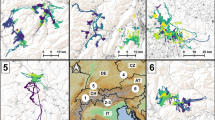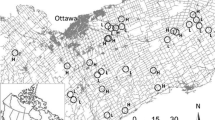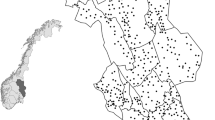Abstract
Recent studies have highlighted the positive effects of road verges on the abundance of small mammals. However, most of these studies occurred in intensively grazed or cultivated areas, where verges were the last remnants of suitable habitats, which could mask the true effects of roads on population traits. We analysed the effects of roads on small mammal populations living in a well-preserved Mediterranean forest. We used the wood mouse (Apodemus sylvaticus) as a model of forest-dwelling small mammals that probably are among the species most affected by road clearings. Our study compared populations in similar habitat areas with and without road influence. We assessed abundance, survival and temporary emigration using extended Pollock’s robust design capture-recapture models. Moreover, we analysed population turnover, sex ratio, age structure and body condition. We found that wood mouse abundance and body condition were lower at the road bisected area, whereas the remaining population traits were similar. This suggests that the reduced habitat availability and quality due to the physical presence of the road and verge vegetation clearing are the main drivers of demographic differences in wood mouse populations between areas. Nevertheless, our results also suggest that in high-quality habitats surrounding national roads, wood mouse populations present similar dynamics to others living in undisturbed areas, despite the decrease in abundance and body condition. Overall, the often-reported increased small mammal abundance in road surroundings should not be generalized independently of habitat quality or to other population traits.


Similar content being viewed by others
References
Alcántara M, Díaz M (1996) Patterns of body weight, body size, and body condition in the wood mouse Apodemus sylvaticus l.: effects of sex and habitat quality. Proc I Eur Congr Mammal, Museu Bocage, Lisboa, 141–149
Ascensão F, Clevenger AP, Grilo C, Filipe J, Santos-Reis M (2012) Highway verges as habitat providers for small mammals in agrosilvopastoral environments. Biodivers Conserv 21:3681–3697
Ascensão F, Mata C, Malo JE, Ruiz-Capillas P, Silva C, Silva AP, Santos-Reis M, Fernandes C (2016) Disentangle the causes of the road barrier effect in small mammals through genetic patterns. PLoS One 11:e0151500
Arnold TW (2010) Uninformative parameters and model selection using Akaike’s Information Criterion. J Wildl Manag 74:1175–1178
Barrows CW, Allen MF, Rotenberry JT (2006) Boundary processes between a desert sand dune community and an encroaching suburban landscape. Biol Conserv 131:486–494
Bailey LL, Simons TR, Pollock KH (2004) Estimating detection probability parameters for Plethodon salamanders using the robust capture–recapture design. J Wildl Manag 68:1–13
Bellamy PE, Shore RF, Ardeshir D, Treweek JR, Sparks TH (2000) Road verges as habitat for small mammals in Britain. Mammal Rev 30:131–139
Benítez-López A, Alkemade R, Verweij PA (2010) The impacts of roads and other infrastructure on mammal and bird populations: a meta-analysis. Biol Conserv 143:1307–1316
Bennett AF (1990) Habitat corridors and the conservation of small mammals in a fragmented forest environment. Landsc Ecol 4:109–122
Bertolino S, Viano C, Currado I (2001) Population dynamics, breeding patterns and spatial use of the garden dormouse (Eliomys quercinus) in an Alpine habitat. J Zool 253:513–521
Bissonette JA, Rosa SA (2009) Road zone effects in small-mammal communities. Ecol Soc 14:27
Borges FJA, Marini MA (2010) Birds nesting survival in disturbed and protected neotropical savannas. Biodivers Conserv 19:223–236
Borchers DL, Buckland ST, Zucchini W (2002) Estimating animal abundance: closed populations. Springer-Verlag, London
Brandstätter E (1999) Confidence intervals as an alternative to significance testing. Method Psych Res Online 4:33–46
Brock RE, Kelt DA (2004) Influence of roads on the endangered Stephens kangaroo rat (Dipodomys stephensi): are dirt and gravel roads different? Biol Conserv 118:633–640
Burnham KP, Anderson DR, White GC, Brownie C, Pollock KH (1987) Design and analysis methods for fish survival experiments based on release-recapture. American Fisheries Society Monograph 5, Bethesda, Maryland
Burnham KP, Anderson DR (2002) Model selection and multi-model inference: a practical information—theoretic approach, 2nd edn. Springer-Verlag, New York
Carvalho F, Mira A (2011) Comparing annual vertebrate road kills over two time periods, 9 years apart: a case study in Mediterranean farmland. Eur J Wildl Res 57:157–174
CGE (2011) Dados Meteorológicos do Centro de Geofísica de Évora. CGE, Universidade de Évora, Évora. http:// www.cge.uevora.pt/. Accessed 25 May 2011
Cooch EG, White GC (2013) Program MARK: a gentle introduction. http://www.phidot.org/software/mark/docs/book. Accessed 26 Jun 2013
D’Amico M, Périquet S, Román J, Revilla E (2016) Road avoidance responses determine the impact of heterogeneous road networks at a regional scale. J App Ecol 53:181–190
Delibes-Mateos M, Smith AT, Slobodchikoff CN, Swenson JE (2011) The paradox of keystone species persecuted as pests: a call for the conservation of abundant small mammals in their native range. Biol Conserv 144:1335–1346
Díaz M, Alonso CL (2003) Wood mouse Apodemus sylvaticus winter food supply: density, condition, breeding, and parasites. Ecol 84:2680–2691
Downing RJ, Rytwinski T, Fahrig L (2015) Positive effects of roads on small mammals: a test of the predation release hypothesis. Ecol Res 30:651–662
Efford M (1992) Comment—revised estimates of the bias in ‘minimum number alive’ estimator. Can J Zool 70:628–631
EP (2005) Recenseamento do tráfego – Évora. Estradas de Portugal, E.P.E.
Fahrig L, Rytwinski T (2009) Effects of roads on animal abundance: an empirical review and synthesis. Ecol Soc 14:21
Ford AT, Fahrig L (2008) Movement patterns of eastern chipmunks (Tamias striatus) near roads. J Mammal 89:895–903
Forman RTT, Sperling D, Bissonette JA, Clevenger AP, Cutshall CD, Dale VH, Fahrig L, France R, Goldman CR, Heanue K, Jones JA, Swanson FJ, Turrentine T, Winter TC (2003) Road ecology. Island Press, Washington, DC
Garratt CG, Minderman J, Whittingham MJ (2012) Should we stay or should we go now? What happens to small mammals when grass is mown, and the implications for birds of prey. Ann Zool Fennici 49:113–122
Getz LL, Cole FR, Gates DL (1978) Interstate roadsides as dispersal routes for Microtus pennsylvanicus. J Mammal 59:208–212
Goosem M (2000) Effects of tropical rainforest roads on small mammals: edge changes in community composition. Wildl Res 27:151–163
Gurnell J (1978) Seasonal changes in numbers and male behavioural interaction in a population of wood mice, Apodemus sylvaticus. J Anim Ecol 47:741–755
Gurnell J, Flowerdew JR (2006) Live trapping small mammals. A practical guide. The Mammal Society, London
Jubete F (2002) Apodemus sylvaticus (Linnaeus, 1785). In: Palomo LJ, Gisbert J (eds) Atlas de los Mamíferos terrestres de España. Dirección General de Conservación de la Naturaleza-SECEM-SECEM, Madrid, pp 404–407
Kendall WL, Pollock KH, Brownie C (1995) A likelihood-based approach to capture-recapture estimation of demographic parameters under the robust design. Biometrics 51:293-308
Kendall WL, Nichols JD, Hines JE (1997) Estimating temporary emigration using capture-recapture data with Pollock’s robust design. Ecol 78:563–578
La Haye MJJ, Swinnen KRR, Kuiters AT, Leirs H, Siepel H (2014) Modelling population dynamics of the common hamster (Cricetus cricetus): timing of harvest as a critical aspect in the conservation of a highly endangered rodent. Biol Conserv 180:53–61
Legendre P (2011) lmodel2: Model II Regression. R package version 1.7–0. http://CRAN.R-project.org/package=lmodel2
Lowry H, Lill A, Wong BBM (2013) Behavioural responses of wildlife to urban environments. Biol Rev 88:537–549
Macpherson D, Macpherson JL, Morris P (2011) Rural roads as barriers to the movements of small mammals. Appl Ecol Environ Res 9:167–180
Mañosa S, Cordero PJ (1992) Seasonal and sexual variation in the diet of the common buzzard in Northeastern Spain. J Raptor Res 26:235–238
Marcheselli M, Sala L, Mauri M (2010) Bioaccumulation of PGEs and other traffic-related metals in populations of the small mammal Apodemus sylvaticus. Chemosphere 80:1247–1254
McGregor RL, Bender DJ, Fahrig L (2008) Do small mammals avoid roads because of the traffic? J Appl Ecol 45:117–123
Meunier F, Gauriat C, Verheyden C, Jouventin P (1999) Bird communities of highway verges: influence of adjacent habitat and roadside management. Acta Oecol 20:1–13
Montgomery WI (1989a) Population regulation in the wood mouse, Apodemus sylvaticus. I. Density dependence in the annual cycle of abundance. J Anim Ecol 58:465–475
Montgomery WI (1989b) Population regulation in the wood mouse, Apodemus sylvaticus. II. Density dependence in spatial distribution and reproduction. J Anim Ecol 58:477–494
Musser G, Ruedas L (2008) Niviventer cameroni. The IUCN Red List of Threatened Species 2008:e.T136512A4302696
Navarro-Castillla A, Mata C, Ruiz-Capillas P, Palme R, Malo JE, Barja I (2014) Are motorways potential stressors of roadside wood mice (Apodemus sylvaticus) populations? PLoS One 9:e91942
Oxley DJ, Fenton MB, Carmody GR (1974) The effects of roads on populations of small mammals. J Appl Ecol 11:51–59
Peig J, Green AJ (2010) The paradigm of body condition: a critical reappraisal of current methods based on mass and length. Funct Ecol 24:1323–1332
Pezzo F, Morimando F (1995) Food habits of the barn owl, Tyto alba, in a Mediterranean rural area: comparison with the diet of two sympatric carnivores. Bol Zool 62:369–373
Pinheiro J, Bates D, DebRoy S, Sarkar D, R Core Team (2015). nlme: linear and nonlinear mixed effects models. R package version 3.1–120. http://cran.r-project.org/package=nlme
Pinto-Correia T, Mascarenhas J (1999) Contribution to the extensification/intensification debate: new trends in the Portuguese montado. Landsc Urban Plan 46:125–131
Pita R, Mira A, Beja P (2006) Conserving the Cabrera vole, Microtus cabrerae, in intensively used Mediterranean landscapes. Agric Ecosyst Environ 115:1–5
Planillo A, Malo JE (2013) Motorway verges: paradise for prey species? A case study with the European rabbit. Mamm Biol 78:187–192
Pollock KH (1982) A capture-recapture design robust to unequal probability of capture. J Wildl Manag 46:752–757
Pollock KH, Nichols JD, Brownie C, Hines JE (1990) Statistical inference for capture–recapture experiments. Wildl Monogr 107:1–97
Pollock KH, Nichols JD, Simons TR, Farnsworth GL, Bailey LL, Sauer JR (2002) Large scale wildlife monitoring studies: statistical methods for design and analysis. Environmetrics 13:105–119
R Core Team (2011) R: a language and environment for statistical computing. R Foundation for Statistical Computing, Vienna, Austria. ISBN 3–900051–07-0, http://www.R-project.org/
Redon L, Machon N, Kerbiriou C, Jiguet F (2010) Possible effects of roadside verges on vole outbreaks in an intensive agrarian landscape. Mamm Biol 75:92–94
Rosário IT, Mathias ML (2004) Annual weight variation and reproductive cycle of the wood mouse (Apodemus sylvaticus) in a Mediterranean environment. Mamm 68:133–140
Ruiz-Capillas P, Mata C, Malo JE (2013) Road verges are refuges for small mammal populations in extensively managed Mediterranean landscapes. Biol Conserv 158:223–229
Ruiz-Capillas P, Mata C, Malo JE (2015) How many rodents die on the road? Biological and methodological implications from a small mammals’ roadkill assessment on a Spanish motorway. Ecol Res 30:417–427
Sabino-Marques H, Mira A (2011) Living on the verge: are roads a more suitable refuge for small mammals than streams in Mediterranean pastureland? Ecol Res 26:277–287
Sanders TA, Trost RE (2013) Use of capture–recapture models with mark-resight data to estimate abundance of Aleutian cackling geese. J Wildl Manag 77:1459–1471
Sarmento P (1996) Feeding ecology of the European wildcat Felis silvestris in Portugal. Acta Theriol 41:409–414
Serafini P, Lovari S (1993) Food habits and trophic niche overlap of the red fox and the stone marten in a Mediterranean rural area. Acta Theriol 38:233–244
Sikes RS, Gannon WL, Animal Care and Use Committee of the American Society of Mammalogists (2011) Guidelines of the American Society of Mammalogists for the use of wild mammals in research. J Mammal 92:235–253
Silva S, Ranjeewa ADG, Weerakoon D (2011) Demography of Asian elephants (Elephas maximus) at Uda Walawe National Park, Sri Lanka based on identified individuals. Biol Conserv 144:1742–1752
Sokal RR, Rohlf JR (1997) Biometry: the principles and practice of statistic in biological research, 3rd edn. WH Freeman and Company, New York
Tête N, Fritsch C, Afonso E, Coeurdassier M, Lambert J-C, Giraudoux P, Scheifler R (2013) Can body condition and somatic indices be used to evaluate metal-induced stress in wild small mammals? PLoS One 8:e66399
Torres A, Jaeger JAG, Alonso JC (2016) Assessing large-scale wildlife responses to human infrastructure development. Proc Nat Acad Sci 113:8472–8477
van Horne B (1983) Density as a misleading indicator of habitat quality. J Wildl Manag 47:893–901
Wang G, Getz LL (2007) State-space models for stochastic and seasonal fluctuations of vole and shrew populations in east-central Illinois. Ecol Model 207:189–196
Ware HE, McClure CJW, Carlisle JD, Barber JR (2015) A phantom road experiment reveals traffic noise is an invisible source of habitat degradation. PNAS 112:12105–12109
White GC, Anderson DR, Burnham KP, Otis DL (1982) Capture-recapture and removal methods for sampling closed populations. Los Alamos National Laboratory, Los Alamos, New Mexico
White GC, Burnham KP (1999) Program MARK: survival estimation from populations of marked animals. Bird Study 46:120–139
Zuberogoitia I, Martínez JE, Martínez JA, Zabala J, Calvo JF, Castillo I, Azkona A, Iraeta A, Hidalgo S (2006) Influence of management practices on nest site habitat selection, breeding and diet of the common buzzard Buteo buteo in two different areas of Spain. Ardeola 53:83–98
Acknowledgements
This study was funded by the Portuguese Foundation for Science and Technology (FCT; POPH/FSE) through a PhD grant attributed to AG (SFRH/BD/66382/2009). Unidade de Biologia da Conservação (UBC) and Instituto de Ciências Agrárias e Ambientais Mediterrânicas (ICAAM) provided additional funding. We thank the landowners for allowing us to use their land. We are grateful to André Lourenço, André Silva, Clara Ferreira, Denis Medinas, Edgar Gomes, Helena Marques, Marta Duarte, Pedro Costa, Rafael Carvalho, Sara Valente and Tiago Marques for the kind assistance in different stages of data collection. We thank the valuable comments from Ricardo Pita and Sara Santos. We thank the suggestions from the handling editor and two anonymous reviewers that greatly improved our paper. We also thank the support from the analysis forum at http://www.phidot.org.
Author information
Authors and Affiliations
Corresponding author
Ethics declarations
This research involves animals.
Ethical approval
All applicable international, national, and/or institutional guidelines for the care and use of animals were followed. All the procedures followed the guidelines approved by the Portuguese Institute for Nature and Forest Conservation (ICNF - Instituto de Conservação da Natureza e das Florestas) and the American Society of Mammalogists for the use of wild mammals in research (Sikes et al. 2011).
Conflict of interest
The authors declare that they have no conflict of interest.
Electronic supplementary material
ESM 1
(PDF 66 kb)
Rights and permissions
About this article
Cite this article
Galantinho, A., Eufrázio, S., Silva, C. et al. Road effects on demographic traits of small mammal populations. Eur J Wildl Res 63, 22 (2017). https://doi.org/10.1007/s10344-017-1076-7
Received:
Revised:
Accepted:
Published:
DOI: https://doi.org/10.1007/s10344-017-1076-7




